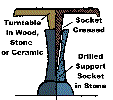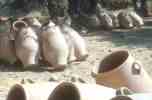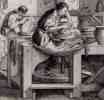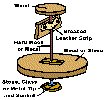To Index Home Page
Ceramic Web Page Tutorial
[2]
The Potter's Wheel
Latest Revision 6th April 2001
by Victor Bryant
PART I . 1. - 8. PREHISTORIC AND ANCIENT POTTERY (Frames)
To make a quick survey of the text or images in this tutorial:
- Scroll down through this page. Click on any thumbnail image and a larger image will appear in the left frame.
- To scroll through all the larger (left frame) images, click on the icon below and use the scrolling bar to view them in sequence.
From Coiling to Throwing
In this tutorial we examine the origins and early development of what is perhaps the most important piece of pottery equipment - the potters wheel. We see how improvements in coiling methods eventually lead to the technique we call (in English) "throwing".
The Sumerian Culture - The First Urban Civilization
The story probably begins in the Middle East around 4000 BC. The village settlements were growing in size and prosperity. A new phase in man's development was happening. In what is today southern Iraq, or Ancient Mesopotamia, the first urban civilization was being created; villages grew into towns and then towns into the great city states: Ur, Uruk, Ubaid, Eridu, Lagesh etc. By 3000 BC. the people of these cities, the Sumerians, had already established a sophisticated trading commercial culture. This was the first town and city based civilization on this planet. New crafts and occupations evolved. More skills and tools were invented.
The Effects of Specialising
To a great extent all was triggered as a result of increased division of labour and job specialisation within earlier small communities. Of course some men still hunted and fished, but others now planted crops and reared animals and, as they became more experienced, farming methods improved, food production increased and so did the population. Trade expanded over the whole region. More pots were needed and various ways were tried to speed up all the pottery techniques: making, decorating and firing.
Who did what - Men or Women?
Most of these changes affected the work and life style of the men much more than their womenfolk. Most women were already almost fully occupied and "specialising" in the vital task of bearing and rearing children. Any other tasks done by the women must therefore have been part-time and close to the home. Women almost certainly developed the techniques of sewing, weaving and basket making in most prehistoric communities. They were probably also the first real potters - the makers of bowls, dishes, jugs etc. so it is not surprising that in these early village societies building a basket and coiling a pot had a lot in common.
Coiling Pots
 The ancient technique of building a coiled pot involves squeezing, squashing and smoothing the successive layers of coils into a thin even wall which swells or tapers as it grows and encloses a shape. To do this you need to turn the pot around slowly as you work.
The ancient technique of building a coiled pot involves squeezing, squashing and smoothing the successive layers of coils into a thin even wall which swells or tapers as it grows and encloses a shape. To do this you need to turn the pot around slowly as you work.
Early potters soon learned to make the task of periodically turning the pot much easier and more efficient by beginning their coiling on a dish or bowl, or even a flat plate or smooth platter they could twist round as they worked.

 Most early coiled pots are round bottomed. They were probably started in a bowl which could be easily turned or rolled around whilst adding and smoothing the clay coils.
Most early coiled pots are round bottomed. They were probably started in a bowl which could be easily turned or rolled around whilst adding and smoothing the clay coils.
 Other coiled pots taper downwards to a small base. This would make the pots easier to turn whilst coiling.
Other coiled pots taper downwards to a small base. This would make the pots easier to turn whilst coiling.
The base was probably started by pressing a lump of soft clay or a spiral of coils into a shallow round bottomed bowl and smoothing it out with the fingers or a piece of wood or a bone rib. Coils were then added progressively. The shallow bowl gave support to the soft clay as first coils were added. The rounded bottom made it easy to pull the pot around bit by bit. As the base and lower coils gradually dried and hardened progressively they gave firmer support to the soft coils being added above.
In more remote regions of the world women are probably still coiling pots in this way. These illustrations show these methods still being used within the last century in some African villages.
 Squatting down with the bowl between the legs. It is easy to turn such a bowl as each coil is added and squeezed and smoothed into the wall.
Squatting down with the bowl between the legs. It is easy to turn such a bowl as each coil is added and squeezed and smoothed into the wall.
 Adding and squeezing a coil as the wall is built.
Adding and squeezing a coil as the wall is built.
 Adding small coils at the neck of the pot. Ready to build out the rim.
Adding small coils at the neck of the pot. Ready to build out the rim.
 Thinning and opening to make a rim.
Thinning and opening to make a rim.
 Drying the pots.
Drying the pots.
Finished pots have been allowed to dry completely in the sun, piled up in a heap on brushwood and bundles of dried grass.
 An open bonfire of the finished pots.
An open bonfire of the finished pots.
More brushwood piled around the dried pile of pots, the bonfire lighted and then fed with more bundles of dry grass.
Platters and bowls for faster coiling.
 Innumerable ways developed of using a platter or bowl to speed up coiling. Here is an example found in the Indian subcontinent. However, soon after 4000 BC. in Mesopotamia a new discovery/invention was being exploited...
Innumerable ways developed of using a platter or bowl to speed up coiling. Here is an example found in the Indian subcontinent. However, soon after 4000 BC. in Mesopotamia a new discovery/invention was being exploited...
The Arrival of the Wheel
 The principle of the Wheel was discovered earliest in southern Iraq(Mesopotamia).
The principle of the Wheel was discovered earliest in southern Iraq(Mesopotamia).
By discovering the principle of the wheel, the Sumerians were able to give up pulling provisions or people along on sledges or dragging heavy objects over a series of logs. They devised how to construct the first carts and chariots.
 This strange wedge shaped object c. 3000 BC. was found in an ancient Sumerian royal grave at Ur in Iraq. (It may have been a sounding box for a harp). It includes perhaps the earliest drawings of wheeled carts or chariots. The whole surface is covered with a decoration made up of tiny carved pieces of lapis, ivory and limestone stuck together on the wooden box with bitumen; a sort of mosaic with engraved drawing. There are two main rectangular panels illustrating a great battle and then the plunder and celebration.
This strange wedge shaped object c. 3000 BC. was found in an ancient Sumerian royal grave at Ur in Iraq. (It may have been a sounding box for a harp). It includes perhaps the earliest drawings of wheeled carts or chariots. The whole surface is covered with a decoration made up of tiny carved pieces of lapis, ivory and limestone stuck together on the wooden box with bitumen; a sort of mosaic with engraved drawing. There are two main rectangular panels illustrating a great battle and then the plunder and celebration.
 This is a detail from the Battle scene: Warriors in a horse drawn cart or chariot. This new weapon of war has four wooden wheels made out of two semicircular pieces bolted together. It must have been a deadly weapon at the time. Soon potters and other craftsmen found more peaceful uses for the wheel...
This is a detail from the Battle scene: Warriors in a horse drawn cart or chariot. This new weapon of war has four wooden wheels made out of two semicircular pieces bolted together. It must have been a deadly weapon at the time. Soon potters and other craftsmen found more peaceful uses for the wheel...
Faster Coiling on a Turntable...
Eventually a small turntable or "tournette" was developed. With this a pot could be turned around much more easily and quickly. The pot making technique in Mesopotamia now gradually gradually changed during the third millennium BC as the more potters adopted the turntable for making and decorating. However, it took a long time for free running steady turntables to be developed, therefore "throwing", as we understand the technique today, did not develop for a long time to come. It would be more accurate to describe this turntable making process as "fast coiling".
And Men Became The Potters...
Until the arrival of the wheel, the women usually made the pots - by coiling. With so many other responsibilities they could only be part-time potters. With the invention of the wheel, men appear to take over from their womenfolk the task of making pottery in most ancient cultures. The villages of the Near East were now growing into towns. More pottery was needed. Probably this need for increased pottery production proved impossible for the women to do with their considerable commitments to child rearing and food preparation. Although one person can make pots more quickly with a wheel, still more full-time labour is needed to decorate, finish and fire this increasing amount of pottery. Clearly, in all communities many people now became full-time potters from the third millennium BC. onwards.
It appears that predominantly Matriarchal village societies gradually became dominantly Patriarchal as bigger urban communities became more organised and complex. (These important social changes could be studied elsewhere in more detail.)
The Egyptian Potter (male) - shown in Tomb Paintings
The earliest records of the potter's trade and in particular the development of the wheel can be seen in the records and pictures made by the Egyptians from about 2500 BC. down to Roman times. Below are scenes which illustrate the essentials of the potters craft in ancient Egypt. These line drawings are based on wall paintings in Egyptian tombs. Click on the thumbnail image for a larger version.
 |
 |
 |
 |
 |
Turntables and Wheels in Egypt

 The invention of a simple wooden turntable probably occurred before 3000 BC. Ancient Egyptian tomb paintings, during the next 2000 years or more, depict potters at work using a number of different versions of turntables made from wood and stone.
The invention of a simple wooden turntable probably occurred before 3000 BC. Ancient Egyptian tomb paintings, during the next 2000 years or more, depict potters at work using a number of different versions of turntables made from wood and stone.

 These drawings show in more detail the structure of turntables which were devised. Both types of turntable appear in early Egyptian wall-paintings. By this time pottery vessels could now be coiled and smoothed very evenly; and made quite quickly.
These drawings show in more detail the structure of turntables which were devised. Both types of turntable appear in early Egyptian wall-paintings. By this time pottery vessels could now be coiled and smoothed very evenly; and made quite quickly.
![]() The little limestone statuette of an ancient Egyptian potter was made about 2000 BC. It helps us to see how the potter's wheel evolved from a simple turntable pulled round with the hand. The technique was at first just a faster method of coiling. Village potters still use this method in some parts of the world.
The little limestone statuette of an ancient Egyptian potter was made about 2000 BC. It helps us to see how the potter's wheel evolved from a simple turntable pulled round with the hand. The technique was at first just a faster method of coiling. Village potters still use this method in some parts of the world.
The earliest turntables were probably not very free-turning, but gradually potters learned how to make the shaft/pivot/bearings with less friction, and much heavier turntables. Both improvements increased the speed, momentum and power of the wheel. Eventually it would become possible for a faster and heavier turntable/potter's wheel to be used for "throwing" a pot.
With a Wheel - New Shapes And Decoration
The appearance of stemmed clay goblets and pottery decoration with smooth spirals and true circles are evidence of the use of the potters wheel.
![]() The Goblet: this shape consists of two separate forms - a bowl and a stem. It is quite possible to coil a dish or bowl with a stem in clay without using a wheel, but the whole form will have a somewhat irregular quality.
The Goblet: this shape consists of two separate forms - a bowl and a stem. It is quite possible to coil a dish or bowl with a stem in clay without using a wheel, but the whole form will have a somewhat irregular quality.
![]() In fact potters only began making bowls with stems when the wheel arrived. - A variety of smooth regular curved shapes can be made quickly and easily using a potters wheel. When leather hard the pieces can be joined together with slip.
In fact potters only began making bowls with stems when the wheel arrived. - A variety of smooth regular curved shapes can be made quickly and easily using a potters wheel. When leather hard the pieces can be joined together with slip.
Evidence of the Faster Wheel
![]() A much later example from Cyprus in the 7th century BC. This terracotta flask was thrown in three parts, joined together and then brush painted with slip on a wheel - circular lines, bands and spirals.
A much later example from Cyprus in the 7th century BC. This terracotta flask was thrown in three parts, joined together and then brush painted with slip on a wheel - circular lines, bands and spirals.
The Fast Coiling Method Flourished
Strangely, the technique of making a pot changed only gradually over the centuries, even though the pottery wheel improved quite rapidly. Most pots were still made by coiling but the faster wheel enabled much larger coils to be blended together faster and gradually squashed and smoothed into a thin even wall using fingers and ribs. This "Fast Coiling" method is still common in many village potteries of the Mediterranean, the Middle East and Asia even today. The "throwing" technique never fully developed in many cultures. Potters used the wheel for faster smoother coiling, often using soft but enormously thick coils. Enormous storage jars were made by coiling and we can still find village potters today working this way in Western Asia and the Eastern Mediterranean.
Coiling on the Wheel Today
 In this photo a 20th century Afghan village potter is building up coils onto a wheel ready to press and smooth them together to raise the wall of this pot.
In this photo a 20th century Afghan village potter is building up coils onto a wheel ready to press and smooth them together to raise the wall of this pot.
![]() Here a 20th century Turkish potter adds a coil to a pot he is making on a wheel. He turns the heavy flywheel slowly with his foot whilst gradually lowering the thick coil of clay off his shoulder onto the stiff wall of the partly built pot.
Here a 20th century Turkish potter adds a coil to a pot he is making on a wheel. He turns the heavy flywheel slowly with his foot whilst gradually lowering the thick coil of clay off his shoulder onto the stiff wall of the partly built pot.
Most village potters in Crete continue to made pots essentially by coiling on a wheel. Here are two photographs of Cretan potters.
![]() First photo: The coil of clay looks like a long french bread roll.
First photo: The coil of clay looks like a long french bread roll.
In the second photo the potter has thinned and smoothed out the last coil adding to the height of the pot wall. He uses a flat piece of bone for smoothing. After allowing the soft wall to dry a little and stiffen up, the next coil would be added and the process repeated.
 These stacks of fired storage jars were made by the two Cretan potters shown fast coiling similar pots. The pots were fired in a simple open updraft kiln using vine clippings as fuel.
These stacks of fired storage jars were made by the two Cretan potters shown fast coiling similar pots. The pots were fired in a simple open updraft kiln using vine clippings as fuel.
High or Low?
 From the Eastern Mediterranean world into Europe the potters wheel developed into a bench high turntable with a large heavy flywheel at foot level, as illustrated in a book on pottery making techniques from 16th century Italy.
From the Eastern Mediterranean world into Europe the potters wheel developed into a bench high turntable with a large heavy flywheel at foot level, as illustrated in a book on pottery making techniques from 16th century Italy.
Low Friction bearings and a Heavy Flywheel
 19th century French potters using sturdy fast wheels, but very similar in design to the previous 16th century ones.
19th century French potters using sturdy fast wheels, but very similar in design to the previous 16th century ones.
Until the continuous power-driven wheel arrived, the throwing technique was possible only with a low friction, fast, heavy momentum wheel. Where such smoother running heavy wheels were devised the technique of 'throwing' did gradually develop. "Throwing" seems a puzzling use of the modern English word, but it derives from the Old English or Saxon term "to twist".
The Cyclical Throwing Technique
Throwing with this type of wheel is cyclical. The potter kicks the heavy flywheel until it is revolving quite fast then works on the lump of fairly soft clay. As the speed of the wheel drops, it become more difficult to work on the clay. So the potter stops throwing and kicks the flywheel up to speed again. This cyclical process is repeated until the work is finished. The lump of clay used is relatively soft, and slurry, rather than water, is used for lubrication. A large apron of some sort is needed for protection as usually there is no tray! A large sheet of soft leather was used as well in later workshops. Compare the last two illustrations.
The Basic Momentum Wheel
 The main difference between the 16ht and the 19th century wheels is in the materials used to make them. Like the 16th century Italian wheel, the model on the left is mostly made of wood with a strip of greased leather used as an upper bearing and a metal point and a stone or glass socket at the base.
The main difference between the 16ht and the 19th century wheels is in the materials used to make them. Like the 16th century Italian wheel, the model on the left is mostly made of wood with a strip of greased leather used as an upper bearing and a metal point and a stone or glass socket at the base.
The Modern Momentum Wheel
 Like the 19th century French example, later versions from more recent times would use a thick iron or steel rod and greased metal bearings. The most recent models models run very smoothly and have very little friction and are almost silent. Until the industrial revolution in 18-19th century Europe the potter's wheel hardly changed. Many individual potters today still prefer this silent cyclical momentum kick wheel to the modern variable speed electric wheel.
Like the 19th century French example, later versions from more recent times would use a thick iron or steel rod and greased metal bearings. The most recent models models run very smoothly and have very little friction and are almost silent. Until the industrial revolution in 18-19th century Europe the potter's wheel hardly changed. Many individual potters today still prefer this silent cyclical momentum kick wheel to the modern variable speed electric wheel.
Differences East and West

 From the Indian continent to the Far Eastern World a distinctive variation of the potter's wheel developed. The heavy flywheel itself was often the throwing table. Sometimes as shown here balanced on a fine point with the weight carefully distributed. Instead of kicking the wheel it was speeded up using a rod or stick.
From the Indian continent to the Far Eastern World a distinctive variation of the potter's wheel developed. The heavy flywheel itself was often the throwing table. Sometimes as shown here balanced on a fine point with the weight carefully distributed. Instead of kicking the wheel it was speeded up using a rod or stick.
 In China and Japan it is was usual for the potter to sit at or near ground level, not on a raised seat as in the West. Sometimes, controlling the speed of the wheel was the job of an assistant.
In China and Japan it is was usual for the potter to sit at or near ground level, not on a raised seat as in the West. Sometimes, controlling the speed of the wheel was the job of an assistant.
 Inexplicably the Eastern potter has traditionally turned his wheel clockwise whilst Western potter usually turns his anti clockwise!
Inexplicably the Eastern potter has traditionally turned his wheel clockwise whilst Western potter usually turns his anti clockwise!
Trying out the technique
For anyone today who has only used an electric wheel, throwing on a traditional momentum wheel is a new and unnerving experience. It is however easy to understand and can become addictive.
-
The process is cyclical:
- The wheel or flywheel is turned or kicked until moving fast enough to throw or centre.
- A fairly soft clay ball is then centred and opened out. Gradually friction will cause the wheel to slow down. At some point you stop throwing. Only you can decide when the speed becomes too slow.
- The wheel has then to be kicked or turned until it is up to a fast speed once again.
- This cyclical process (kicking then throwing) is repeated until the pot is finished.
- Slurry rather than water lubricates the pot.
Summary: Tutorial No.2. The Origin and Development of the Potters Wheel
For the next tutorial
click below:
The
Bonfires improve and develop into kilns.
![]()

Adapted from the original versions which were written for my series of weekly illustrated lectures to ceramic students including those on the the Harrow Studio Pottery Degree Course, Westminster University and The Central School of Art & Design, London U.K. from 1973 - 1994
A book based on these web tutorials is now in preparation
Latest Revision for Web Page 1st April 2001
Victor Bryant ©1994,2001

Click to make a comment
or ask a question.


